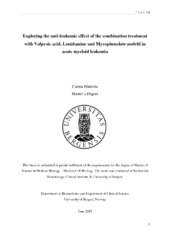Exploring the anti-leukemic effect of the combination treatment with Valproic acid, Lonidamine and Mycophenolate mofetil in acute myeloid leukemia
Master thesis
Permanent lenke
https://hdl.handle.net/1956/10169Utgivelsesdato
2015-06-01Metadata
Vis full innførselSamlinger
Sammendrag
An accumulation of immature myeloid progenitor cells at the expense of normal hematopoietic precursors characterizes the aggressive heterogeneous cancer acute myeloid leukemia (AML). It affects the bone marrow and peripheral blood leading to defects in myeloid cell function. (1) The median age of patients with AML is 67 years and the side effects associated with chemotherapy available today can often not be tolerated by this subgroup of patients. (2) Thus, new alternative therapeutic strategies are needed. Valproic acid (VPA) has shown an anti-leukemic effect in 20% of AML patients. The beneficial effect on survival in the Brown Norwegian Myeloid Leukemia (BNML) syngeneic rat leukemia model when treated with the compound was previously investigated and the phosphoproteomic study revealed differentially expressed proteins following VPA treatment. (3) The expression of hexokinase 1 (HK1) and hypoxanthine phosphoribosyltransferin 1 (HPRT1) was reduced by VPA. These proteins are inhibited by the drugs Lonidamine (LND) and Mycophenolate mofetil (MMF), respectively, (4, 5) and were for that reason explored for their anti-leukemic effect and in combination with VPA to enhance AML patients' responsiveness. The ability of MMF to induce cell growth inhibition in three human AML cell lines was assessed and the cooperation of VPA and LND to reduce cell proliferation by synergism was revealed by WST-1 proliferation based assay, Hoechst 33342 dsDNA staining and Annexin-V/PI flow cytometric analysis. Signaling pathways were investigated by Western blot, and a pilot study in NOD/scid/gamma (NSG) mice was performed for estimating the maximum tolerated dose (MTD) of LND. The combination studies of VPA with LND or MMF are novel in AML. Novel agents are hoped for that they will augment the current chemotherapy available for AML patients to overcome drug resistance pathways, and to eventually improve the outcomes for those patients. The observations made may aid in the identification of targeted treatment with combination therapy for individual AML patients. This thesis demonstrates the use of metabolically interfering drugs for a dose-dependent suppression of human AML cell lines and the subsequent viability assays.
